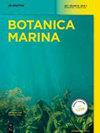更新不列颠和爱尔兰绿色海藻中的莼菜科
IF 1.4
4区 生物学
Q2 MARINE & FRESHWATER BIOLOGY
引用次数: 0
摘要
2007 年的《不列颠和爱尔兰的绿色海藻》植物志没有介绍莼菜科的分子数据,主要是 ITS 序列。随后,随着莼菜物种的模式材料被测序,以及利用 DNA 条形码进行的密集采样增加了新的欧洲物种,莼菜的名称也发生了变化。为了更新莼菜科,我们从 2007 年到 2021 年进行了系统采样,使用各种分子标记物和四个物种的模式材料 DNA 对标本进行鉴定。我们在此表明,根据其主模式的 rbcL、tufA 和 ITS 序列,gigantea 莼菜被归入压缩莼菜(Ulva compressa),而 curvata 莼菜的主模式也被归入压缩莼菜(Ulva curvata)。千层莼(Ulva gigantea sensu GenBank)和假千层莼(Ulva pseudocurvata)是同种。根据标本的 rbcL 序列,正确的名称是 U. pseudocurvata。2007 年植物区系中包括了两个单色莼科物种,但我们发现这两个物种以及所有早期英国单色莼科物种都代表了最初描述自阿拉斯加的一个物种--Ulvaria splendens。Ulva sordida 标本的两个 rbcL 扩增子分析表明,它与 Ulvaria splendens 是同种。我们在英格兰西南部和威尔士西南部采集到的第一批真正的韫莼样本与比斯开湾的顶型材料、加利西亚的最新样本以及不列颠尼未发表的 tufA 序列相对应。本文章由计算机程序翻译,如有差异,请以英文原文为准。
Updating the Ulvaceae in the green seaweeds of Britain and Ireland
The 2007 flora “Green Seaweeds of Britain and Ireland” did not present the molecular data underpinning the Ulvaceae treatment, mostly ITS sequences. Subsequently, names have changed as type material of Ulva species is sequenced and intensive sampling with DNA barcoding adds new European species. To update the Ulvaceae, we systematically sampled from 2007 to 2021, identifying specimens using various molecular markers alongside DNA from type material of four species. We show here that Ulva gigantea , based on rbc L, tuf A and ITS sequences of its holotype, is assigned to Ulva compressa , as is the lectotype of Ulva curvata . Ulva gigantea sensu GenBank and Ulva pseudocurvata are conspecific. The correct name is U. pseudocurvata based on rbc L sequences of the lectotype. Two species of monostromatic Ulvaceae were included in the 2007 flora, but we show that both of them and all earlier British monostromatic collections represent Ulvaria splendens , a species originally described from Alaska. Analysis of two rbc L amplicons of the Ulva sordida lectotype shows that it is conspecific with Ulvaria splendens . Our first genuine collections of Ulvaria obscura from SW England and SW Wales correspond to topotype material from the Bay of Biscay, recent samples from Galicia and unpublished tuf A sequences from Britanny.
求助全文
通过发布文献求助,成功后即可免费获取论文全文。
去求助
来源期刊

Botanica Marina
生物-海洋与淡水生物学
CiteScore
4.10
自引率
4.50%
发文量
43
期刊介绍:
Botanica Marina publishes high-quality contributions from all of the disciplines of marine botany at all levels of biological organisation from subcellular to ecosystem: chemistry and applications, genomics, physiology and ecology, phylogeny and biogeography. Research involving global or interdisciplinary interest is especially welcome. Applied science papers are appreciated, particularly when they illustrate the application of emerging conceptual issues or promote developing technologies. The journal invites state-of-the art reviews dealing with recent developments in marine botany.
 求助内容:
求助内容: 应助结果提醒方式:
应助结果提醒方式:


